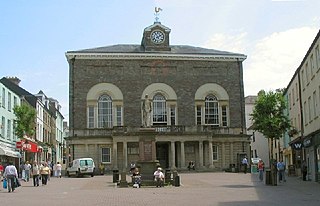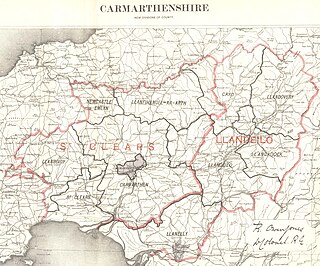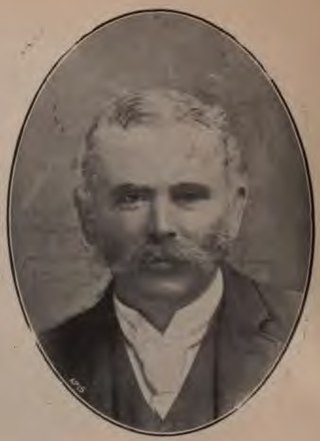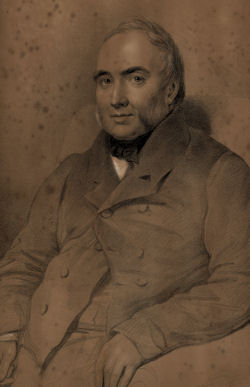Related Research Articles

Carmarthenshire is a county in the south-west of Wales. The three largest towns are Llanelli, Carmarthen and Ammanford. Carmarthen is the county town and administrative centre. The county is known as the "Garden of Wales" and is also home to the National Botanic Garden of Wales.

Carmarthen is the county town of Carmarthenshire and a community in Wales, lying on the River Towy 8 miles (13 km) north of its estuary in Carmarthen Bay. The population was 14,185 in 2011, down from 15,854 in 2001, but gauged at 16,285 in 2019. It has a claim to be the oldest town in Wales – Old Carmarthen and New Carmarthen became one borough in 1546. It was the most populous borough in Wales in the 16th–18th centuries, described by William Camden as "chief citie of the country". Growth stagnated by the mid-19th century as new settlements developed in the South Wales Coalfield.

Llandovery is a market town and community in Carmarthenshire, Wales. It lies on the River Tywi and at the junction of the A40 and A483 roads, about 25 miles (40 km) north-east of Carmarthen, 27 miles (43 km) north of Swansea and 21 miles (34 km) west of Brecon.

Cefn Sidan, translated from Welsh, means "silky ridge". This long sandy beach and its dunes form the outer edge of the Pembrey Burrows between Burry Port and Kidwelly, facing southwestwards over Carmarthen Bay in South Wales. Cefn Sidan beach is backed by dunes, salt marshes, Pembrey Forest and the Pembrey Country Park.

Ulster Bank is a large retail bank, and one of the traditional Big Four Irish clearing banks. The Ulster Bank Group was subdivided into two separate legal entities: National Westminster Bank Plc, trading as Ulster Bank ; and, until April 2023, Ulster Bank Ireland DAC. Prior to the closure of Ulster Bank in the Republic of Ireland in April 2023, the headquarters of Ulster Bank in the Republic of Ireland were located on George's Quay, Dublin, whilst the headquarters of Ulster Bank Northern Ireland are in Donegall Square East, Belfast, and it maintains a large sector of the financial services in both the UK and the Republic of Ireland.

East Carmarthenshire was a county constituency in Carmarthenshire, Wales. It returned one Member of Parliament (MP) to the House of Commons of the Parliament of the United Kingdom, elected by the first past the post voting system.
The Panic of 1825 was a stock market crash that started in the Bank of England, arising in part out of speculative investments in Latin America, including the imaginary country of Poyais. The crisis was felt most acutely in Britain, where it led to the closure of twelve banks. It was also manifest in the markets of Europe, Latin America and the United States. Nationwide gold and silver confiscation ensued and an infusion of gold reserves from the Banque de France saved the Bank of England from collapse. The panic has been called the first modern economic crisis not attributable to an external event, such as a war, and so the start of modern economic cycles. The Napoleonic Wars had been highly profitable for all sectors of the British financial system, and the expansionist monetary actions taken during transition from war to peace brought a surge of prosperity and speculative ventures. The stock market boom became a bubble and banks caught in the euphoria made risky loans.

The Panic of 1866 was an international financial downturn that accompanied the failure of Overend, Gurney and Company in London, and the corso forzoso abandonment of the silver standard in Italy.

Thomas Joplin (1790?–1847) was an English timber merchant and banker, resident in Newcastle upon Tyne, notable as an early and persistent promoter of the concept of the joint stock bank.

National Westminster Bank, trading as NatWest, is a major retail and commercial bank in the United Kingdom based in London, England. NatWest Markets comprises the non-ringfenced investment banking arm, following ringfencing of the group's core domestic business, when the bank became a direct subsidiary of NatWest Holdings. It was established in 1968 by the merger of National Provincial Bank and Westminster Bank. In 2000, it became part of The Royal Bank of Scotland Group, which was re-named NatWest Group in 2020. The British government currently owns 39% of NatWest Group after spending £45 billion bailing out the lender in 2008; the proportion at one point was 54.7%. NatWest International is a trading name of RBS International, which also sits outside the ringfence.

Abel Thomas was a Welsh Liberal politician and lawyer.
Bank y Llong was a Welsh bank. It got its name from an engraving of a ship decorating its bank notes. It was probably the first bank in Aberystwyth and was founded soon after the removal of the Custom House from Aberdyfi to Aberystwyth, around 1762.
The Carmarthen Furnace Bank is a bank established in Carmarthenshire in the 18th century as a result of the efforts of a Welsh entrepreneur and businessman called John Morgan. The banking business started by issuing tokens to facilitate an iron and tin works operation and then developed into a full-fledged bank. However, few records of the works, or the bank, exist.
The Llandovery Bank was established in 1799 in Llandovery, Wales, in the premises known as the King’s Head on Stone Street, where it remained for many years. The bank was locally known as the ‘Black Ox Bank’ because of the bank notes having been embellished with an engraving on the left hand side of a Welsh black ox.
Llanelly Bank was a 19th-century bank based in the Welsh town of Llanelli. The bank used the then-standard Anglicised spelling of the town's name.
Carmarthen Bank was a bank established and formerly operated in the county of Carmarthenshire, Wales during the 19th century. It became bankrupt in 1832 and its name was then adopted by another Carmarthenshire-based bank.
This bank was operating in Pembrokeshire, in Wales during the early 19th century. It became bankrupt in 1826.

The University of Wales Trinity Saint David is a multi-campus university with three main campuses in South West Wales, in Carmarthen, Lampeter and Swansea, a fourth campus in London, England, and learning centres in Cardiff, Wales, and Birmingham, England.

Vincent Stuckey was a merchant and banker of Somerset and Gloucestershire whose note-issue in his heyday was the largest in England and Wales except for the Bank of England itself.
David Morris was a British Whig and Liberal politician, and banker.
References
- 1 2 3 4 5 6 Early Banks in West Wales, by Francis Green (in West Wales Historical Records, The Annual Magazine of The Historical Society of West Wales, Volume VI, edited by Francis Green, Printed by W. Spurrell & Son, 1916)
- 1 2 3 4 http://carmarthenshirehistorian.org/cgi-bin/twiki/view/Historian/CwmCoombACarmarthenshireHouseAndItsFamilies Archived 2008-12-04 at the Wayback Machine Retrieved 27 September 2009
- 1 2 3 heritagearchives.rbs.com https://web.archive.org/web/20110715155852/http://heritagearchives.rbs.com/wiki/David_Morris_%26_Sons%2C_Carmarthen%2C_c.1790-1871. Archived from the original on 15 July 2011. Retrieved 27 September 2009.
{{cite web}}: Missing or empty|title=(help)[ title missing ]